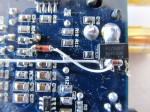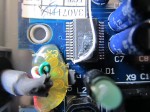Some years ago I got a cheap UCA202 audio interface from Behringer. Unfortunately the Burr-Brown (now TI) USB audio codec pcm2902 is broken by design. The internal voltage reference shows a terrible distortion because the 1 kHz usb clock isn’t decoupled properly. The data sheet recommends the use of an external voltage reference for a high-performance application (figure 37) – unfortunately Behringer uses the circuit for a simple application (like figure 39).
I tested my UCA202 with jaaa, a great tool written by Fons and got a “nice” peak at 1 kHz – it went away after adding a reg103-a to my UCA (you can get free samples from TI).
If you compare figure 37 and 39 of pcm2902 data sheet you’ll see the difference. I’ve soldered the two resistors 27k and 13k directly onto the IC1 (these devices are SMD parts – I had to use a magnifying glass an a very fine pitch soldering iron) and made a connection to the pcm2902.
You can substitute the voltage regulator by any other low drop type – the enable input isn’t imperative. The pcm2902 codec needs about 3.6..4.0 volts at pin 10 to override it’s internal voltage source.
Good luck.
- Tuning UCA202
- img 0852
- img 0853
- img 0854





Hello, I know your post was made 5 years ago, I hope you will respond: “You can substitute the voltage regulator by any other low drop type – the enable input isn’t imperative”. Does that mean just a regulator between USB VBus and pin 3 of the PCM2902?
Thanks!
LikeLike
Hello Hans,
Yes, any low-drop type is sufficient. Connect the input to Vbus and the output via the decoupling schottky diode D1 to pin 10 of the PCM… as in figure 37 of the data sheet (just ignore the two resistors and pin 4 and 5 of IC1). The regulator will draw some quiescent current from the USB Vbus line in standby, this violates the USB specification, but is tolerated by all systems.
Martin
LikeLike
When I tried to buy ‘any low drop’ I asked for a 5Volt low drop. The salesperson then explained to me that a 5 volt regulator connected to USB 5 volt, can not regulate. And a 3.3 volt regulator does not meet the 3.6 volt requirement of pin 10 / Vccci. Can you comment on that?
Thanks again!
LikeLike
Or, maybe I can use a separate power source that is not connected to the ‘dirty’ USB 5 Volt? The Schottky diode is not required in that setup?
LikeLike
You can lift the GND pin of the regulator with a normal diode (+0.7V), rising the output to 4.0V, the voltage drop of the schottky diode gives the 3.7..3.8V at pin 10.
Why don’t you want to use the proposed adjustable REG103, it’s available as sample from TI for free if you register with a company or university mail address.
Or use any other adjustable low-drop regulator, e.g. this one: https://www.segor.de/#Q=LM1086IS-ADJ&M=1
LikeLike
Hi, I’m looking to build something around this IC as a personal project. Can you let me know which are the IC’s that configure the input to the PCM? I can see a JRC4558 but I’m not sure if that’s for the input. Thanks!
LikeLike
Hi Sebastian, the 4558 is located near the earphone output, but there are also two JRC2740 op amps located near the audio in/out connectors. https://datasheetspdf.com/pdf-file/507929/NewJapanRadio/NJM2740/1
LikeLike
Thank you very much! this has been driving me nuts for a good solid week. I found an old ADS Tech RDX-150 “Instant Music” USB audio box in my basement and the only thing that really makes it notable from all other of these pcm2902 devices I’ve researched up is it has RCA in and out as well as optical out like your device here, but also optical in.
I’ve already had to recap the silly thing as the original 2004 caps were starting to leak and smell like dying tuna… and while I went value for value in that case, the UCA202 seems to have some wildly different values in a couple spots here as far as the electrolytics go… so now that I see this, I’m tempted to change a couple values out to match and see how that affects things.
Likewise, the problem you describe here is exactly the same thing I’m facing with the RDX-150. I’m attempting to get that 1KHz tone settled down which is caused by the USB packet frame, and this is exactly the kind of fix I needed. I already shielded the entire inside of the cavity of the device with foil tape connected to board ground, but saw no improvement, until I saw this, and it clicked.
Interestingly, the PCM2902 only has this tone on the input and output if the device it’s plugged into is connected to ground. If I plug it into my phone with an adapter cable for instance, the input is silent. but now that I’ve seen this, I can figure out if I have an appropriate regulator and some appropriate diodes and caps in my collection of spare parts and drop those in. once again, thank you for this absolutely wonderful write-up, 9 years later.
LikeLike